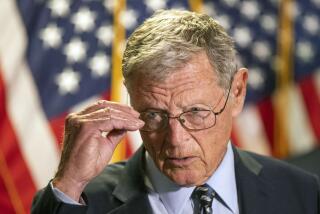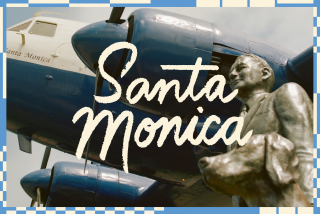Daring Young Man and Flying ‘Sausages’ Made Flight History
- Share via
A fleet of protective airships hovering over America’s borders -- an idea recently floated by the Pentagon -- brings back memories of the role played by pioneers of lighter-than-air craft at the turn of the century.
One of those daring young men was Augustus Roy Knabenshue, who piloted one of America’s first airships, the California Arrow, and went on to found one of the first dirigible passenger services, from Pasadena to Los Angeles, in 1912. He is buried near Burbank Airport in a shrine that memorializes aviation heroes.
Airships, ranging from balloons to dirigibles, have a long history in warfare. Union and Confederate armies used aerial observation posts during the Civil War. Lighter-than-air craft were rediscovered by military planners for surveillance, reconnaissance and bombing in both world wars. And it was just 40 years ago that the Navy retired four dirigibles that had guarded the U.S. from Arctic invasion during the early part of the Cold War.
In war and peace, Knabenshue was at the controls of dirigibles, extolling their virtues in a variety of roles. He built observation balloons for the Army and Navy during World War I and, later, for B.F. Goodrich Co. He managed the Wright brothers’ exhibitions at air meets. He established the National Park Service’s aviation programs for spotting forest fires, taking aerial photographs and surveying wildlife. He was instrumental in organizing Los Angeles’ first international air meet, held at Dominguez Hills in 1910.
Fascinated by Balloons
The son of a newspaper editor, Knabenshue was born in Ohio in 1876. At age 5, he was fascinated by a balloon ascending slowly skyward. As a teenager, he got his first ride in one.
That was all it took to cement his dreams of flight. He bought his first balloon in 1899 with a down payment of $25. To supplement his income while working for the telephone company, he offered rides for a buck.
On Oct. 25, 1904, nine months after Orville and Wilbur Wright sailed 40 yards over Kitty Hawk, N.C., Knabenshue took his balloon to the St. Louis World’s Fair. He competed in several air races, won most of them, and sold rides to spectators.
At the fair he met Capt. Thomas Scott Baldwin, inventor of the California Arrow, a 95-foot-long, cigar-shaped airship filled with explosive hydrogen and powered with a lightweight motorcycle engine.
Even after Knabenshue made some modifications with his trusty sewing machine, the airship proved incapable of lifting off with the 230-pound Baldwin at the helm. Baldwin asked the slimmer Knabenshue to fly in his place.
Knabenshue had never piloted a dirigible; he had to learn on the fly. It took him an hour and a half to travel 11 miles, scooting back and forth on the wooden framework to make the dirigible ascend and descend. But he beat the competition in St. Louis, earning both $1,000 and a name for himself.
“I had to learn to fly that thing ... pronto, and I did. I hit some air currents and people said they were amazed at how I maneuvered,” he said in a 1954 interview. “I wasn’t maneuvering -- I was hanging on.”
Nevertheless, he was hooked. For three days, beginning on Christmas 1904, he raced the California Arrow against automobiles between Los Angeles and Pasadena, winning by two minutes. Depending on the weather, the trip usually took him about 20 minutes.
Knabenshue would build 10 dirigibles for himself. He dubbed his first model Toledo I and began to tour fairs and air shows throughout the nation.
In 1905, New York Times owner and publisher Adolph S. Ochs paid him $10,000 to fly his 69-foot-long Toledo II airship from Central Park and circle the Times Building. It was the first flight of an airship over Manhattan. Two years later, he built the first three-passenger dirigible and, in 1908, took one of his lighter-than-air vehicles on the nation’s first successful night flight.
Back in Los Angeles, in 1909, Knabenshue took off from Tournament Park in Pasadena, the current southwest corner of California Boulevard and Wilson Avenue at Caltech. A year later, at the Dominguez Hills air show, Knabenshue met a “clean-cut kid” named Glenn L. Martin. Two years later, he talked Martin, then 26, into making what would become a historic flight in an early seaplane from Balboa Bay, near Newport Beach, to Catalina.
Martin’s flight time at 3,500 feet was 37 minutes. When he landed, he ate a sandwich, patched a hole in one of his pontoons and flew back. But the round trip took a few hours longer than expected, which didn’t sit well with those anxiously awaiting his return.
“We didn’t know he was delayed making repairs and his mother was breathing hellfire and brimstone about me promoting the flight,” Knabenshue said in the 1954 interview. “When Martin did get back to Balboa, the patch on the pontoon tore loose while he was landing and the plane sank in the bay before we could get it ashore. All was forgiven then, but his mother was suspicious of me from then on.”
Knabenshue’s success attracted the attention of the Wright brothers, who wanted to enter their planes in competitions and wanted Knabenshue to manage their team of pilots and planes.
In 1912, while working off and on for the Wrights, he settled down in Pasadena. He built a balloon hanger in a field on Marengo Avenue and started a passenger and freight service to Los Angeles. He could take 13 passengers at a time on flights from the Raymond Hotel in Pasadena to Chutes Park at Washington Boulevard and Hill Street in Los Angeles. To start with, he charged the unprecedented fee of $25, which he later reduced to $10 to attract more takers.
It was publicity as much as hydrogen that kept Knabenshue Aircraft Corp. afloat for more than a decade.
His dirigible was such a fixture in Pasadena that local residents adopted it -- visiting it, waving goodbye to it and inquiring about it whenever it left home for long periods.
He inspired the Los Angeles Police Department to launch its experimental “sky balloon,” a predecessor of the high-tech military helicopters used for surveillance today.
Government Contract
On Oct. 29, 1915, LAPD Sgt. Hubert Kittle and U.S. Aeronautical Reservist Jack Michael O’Connell, a former LAPD officer, took off from Monrovia and headed toward downtown Los Angeles. Equipped with binoculars and a “wireless telegraph” they hovered over the police station at First and Hill streets, inspecting the faces and details of 400 officers lined up for their semiannual inspection, which included a parade down Broadway in front of City Hall. Today, no one is sure whether the balloon came from Knabenshue or from O’Connell, who at some point founded his own balloon and airship factory.
Two years later, Knabenshue won a government contract to build 25 observation balloons -- which he called “sausages” -- at $6,200 each.
It’s likely that several of Knabenshue’s airships were delivered to Ross Field, the country’s second observation-balloon training school for Army artillery, at what is now the Arcadia County Park and Golf Course. The first balloon school had been founded in Omaha in 1916, a year earlier, but strong winds and a severe winter had prompted the War Department to look for a milder climate.
More than 3,500 members of the Army Balloon Corps trained at Ross Field, named for Cleo J. Ross, the first balloonist killed in action during World War I. From 1917 to 1922, the corps trained spotters, who directed artillery fire from their gondolas as the balloons ascended above enemy lines.
It was hazardous duty. German pilots delighted in shooting the balloons out of the sky. Allied pilots showed a similar enthusiasm when encountering the Kaiser’s fleet.
Honors Abound
After World War I, Knabenshue helped the Navy test airships. Later, President Franklin D. Roosevelt gave him a commission with the Department of the Interior from 1933 to 1944. There, he established aviation programs for the National Park Service.
He was honored for his aviation pioneering by many groups, including the Early Birds of Aviation Inc., a group of 596 men and women who flew by airplane, balloon, glider or airship before Dec. 17, 1916 -- the 13th anniversary of the Wright brothers’ first powered flight. Knabenshue, of course, was a member of that exclusive club.
When he retired in the late 1940s, he was in poor health and destitute. He and his wife lived in an Arcadia trailer park.
Just two months before his death in 1960, at age 83, he made his last publicity appearance in a helicopter. He and aviator Charles Willard were honored at the 50th anniversary of the first Dominguez air show, also known as an “air circus.” Five years later, he was inducted into the National Aviation Hall of Fame in Dayton, Ohio.
Knabenshue’s scripted bronze tablet at the Portal of Folded Wings aviation shrine in Valhalla Memorial Park is directly under the flight path at Burbank Airport.
The plaque reads: “Roy Knabenshue ... America’s first dirigible pilot.”
More to Read
Sign up for Essential California
The most important California stories and recommendations in your inbox every morning.
You may occasionally receive promotional content from the Los Angeles Times.










